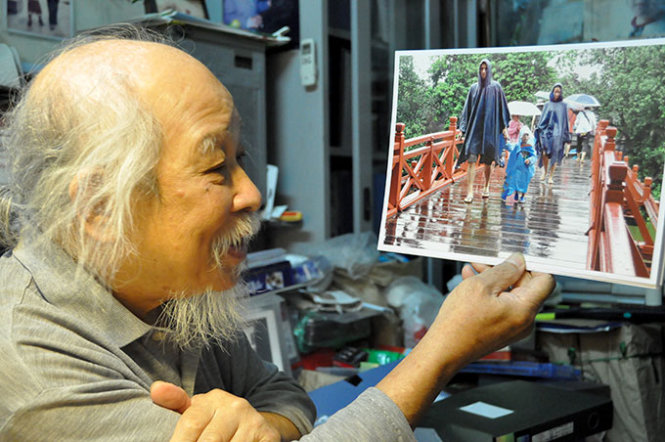A man in his 80s has tirelessly captured Hanoi’s scenery and people with his camera and profound love from the city’s Liberation Day from French rule to the present day.
Photographer Nguyen Quang Phung lives in a small alley in Hoan Kiem District.
His study is packed with photo collections that he has compiled since his youth.
Wartime Hanoi
Phung was one of the witnesses to the historic moment when Vietnamese revolutionary soldiers advanced into Hanoi to free the capital from French rule on October 10, 1954.
He took several prized photos capturing the glorious moments.
On October 9 that year, Phung, a civil servant in his 20s, donned some of his best clothes.
With a borrowed reporter’s name tag he traveled around the city, snapping photos of people.
“On Liberation Day, I witnessed the two extremes of emotions among Hanoians; one being the elation of families whose sons were lucky to survive the war and return home; and the other being the devastation of those whose sons never made it back,” Phung recalled.
He brought out a photo titled “Nhung Dua Tre Doi Bo O Ho Guom” (The Kids Waiting for Their Father at Sword Lake), which he took at 6:00 am on October 10, 1954.
“The kids came from a poor family. I arrived at the lake early that morning, but they were there even before me. One of them told me in tears that they were waiting for their father to come home, whereas their mother was wailing at home over the news of his death,” the old photographer recounted emotionally.
During the U.S. troops’ relentless bombardment of the northern region in 1972, Phung also captured the tragic, mournful atmosphere on Hanoi’s Kham Thien Street.
He also took a photo of kids amidst the wreckage of an evacuation site, which deeply moved many foreigners.
Peacetime Hanoi
Upon his retirement in 1993, he devoted his life to taking photos of his beloved city.
Phung bought photography books from other countries to improve his skills.
Just as he did during his youth, Phung roamed streets and alleys to capture the capital's modern cityscape and people.
He takes great pride in his greatest photographic achievement so far – a collection of photos which he took of local drug addicts.
Even on rainy nights, the old man took great pains to “stalk” groups of addicts beneath the Long Bien Bridge and in the areas surrounding Sword Lake – two of Hanoi’s icons – and snapped photos of them.
He braved their angry reactions and attacks, determined to take the photos to “hopefully contribute to the society’s security and welfare.”
The veteran photographer has also taken thousands of pictures on a bank of the Hong (Red) River – one of the northern region’s icons – where homeless migrants from other provinces gather to eke out a living.
He even hired a boat and lived with them for some time.
Sword Lake is the spot with which he bonds most profoundly.
Once, while he was strolling around the lake, he met a young man whose father is an American veteran who fought in the war.
He told Phung that his father could not bring himself to visit the country because he was tormented by “Vietnam Syndrome,” or Post Traumatic Stress Disorder.
Phung then took a photo of a young soldier and his girlfriend by Sword Lake and sent it to the young man, along with a message that post-war Vietnam now abounds in love and vitality.
“I believe that the photo will help the veteran overcome his guilt complex and get his life back. I wanted him to shake off his remorse and visit Vietnam some day,” Phung said.
Phung has published a photo book titled “Dao Quanh Ho Guom” (A Stroll around Sword Lake).
He added that he is now gathering photos to publish the next one, to be named “Ha Noi Bam Sau Pho Phuong” (Hanoi’s 36 Streets and Wards).
He garnered a local award in recognition of his bond with, and contribution to, Hanoi in 2013.
“I’ve never taken photos for leisure. All my photos are for the purpose of beautifying Hanoi and bringing its people closer together,” the octogenarian stressed.
Like us on Facebook or follow us on Twitter to get the latest news about Vietnam!



















































